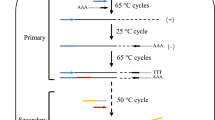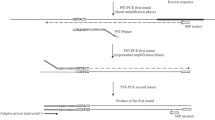Abstract
Although researchers can access information on the entire genomic DNA sequence of typical research organisms, convenient genome walking methods in the laboratory are still needed. For the analysis of microorganisms, these methods are especially useful because the available genetic information is often scarce or limited. Many genomic walking methods are based on the polymerase chain reaction (PCR), and useful methods have been developed. This report reviews the methodologies of PCR-mediated genomic walking methods and evaluates their efficiency and usefulness to help microbiologists to select the appropriate method for each target microorganism. The concept and specific features, such as advantages and disadvantages, of five major PCR-mediated genomic walking methods (random PCR, inverse PCR, panhandle PCR, cassette PCR, and rapid amplification of genomic ends) are briefly described. The improved methods and their characteristics are listed, and a report of experimental comparison of such methods is also introduced briefly. Each of these methods has both advantages and disadvantages, and there is a trade-off between the specificity of target amplification and the ease of the method. The cassette PCR seems to be a standard method, but suitable method should be selected in consideration of the characteristics of the material.




Similar content being viewed by others
References
Aquino VH, Figueiredo LTM (2004) Linear amplification followed by single primer polymerase chain reaction to amplify unknown DNA fragments: complete nucleotide sequence of Oropouche virus M RNA segment. J Virol Methods 115:51–57
Arnold C, Hodgson IJ (1991) Vectorette PCR: a novel approach to genomic walking. PCR Methods Appl 1:39–42
Benkel BF, Fong Y (1996) Long range-inverse PCR (LR-IPCR): extending the useful range of inverse PCR. Genet Anal 13:123–127
Chen X, Wu R (1997) Direct amplification of unknown genes and fragments by uneven polymerase chain reaction. Gene 185:195–199
Cormack RS, Somssich IE (1997) Rapid amplification of genomic ends (RAGE) as a simple method to clone flanking genomic DNA. Gene 194:273–276
Cottage A, Yang A, Maunders H, de Lacy RC, Ramsay NA (2001) Identification of DNA sequences flanking T-DNA insertions by PCR-walking. Plant Mol Biol Rep 19:321–327
Ge Y, Charon NW (1997) Identification of a large motility operon in Borrelia burgdorferi by semi-random PCR chromosome walking. Gene 189:195–201
Huang X-Q, Cloutier S (2007) Hemi-nested touchdown PCR combined with primer-template mismatch PCR for rapid isolation and sequencing of low molecular weight glutenin subunit gene family from a hexaploid wheat BAC library. BMC Genet 8:18
Jones DH, Winistorfer SC (1992) Sequence specific generation of a DNA panhandle permits PCR amplification of unknown flanking DNA. Nucleic Acids Res 20(3):595–600
Jones DH, Winistorfer SC (1993) Genome walking with 2- to 4-kb steps using panhandle PCR. PCR Methods Appl 2:197–203
Jones DSC, Platzer M, Rosenthal A (1994) Extension of incomplete cDNAs (ESTs) by biotin/streptavidin-mediated walking using the polymerase chain reaction. J Biotechnol 35:205–215
Kohda T, Taira K (2000) A simple and efficient method to determine the terminal sequences of restriction fragments containing known sequences. DNA Res 7:151–155
Korpelainen H, Kostamo K, Virtanen V (2007) Microsatellite marker identification using genome screening and restriction-ligation. BioTechniques 42:479–486
Laging M, Fartmann B, Kramer W (2001) Isolation of segments of homologous genes with only one conserved amino acid region via PCR. Nucleic Acids Res 29(2):e8
Leoni C, Gallerani R, Ceci LR (2008) A genome walking strategy for the identification of eukaryotic nucleotide sequences adjacent to known regions. BioTechniques 44:229–235
Lin X, Kelemen DW, Miller ES, Shih JCH (1995) Nucleotide sequence and expression of kerA, the gene encoding a keratinolytic protease of Bacillus licheniformis PWD-1. Appl Environ Microbiol 61(4):1469–1474
Liu Y-G, Whittier RF (1995) Thermal asymmetric interlaced PCR: automatable amplification and sequencing of insert end fragments from P1 and YAC clones for chromosome walking. Genomics 25:674–681
Loh EY, Elliott JF, Cwirla S, Lanier LL, Davis MM (1989) Polymerase chain reaction with single-sided specificity: analysis of T cell receptor δ chain. Science 243:217–220
Mishra RN, Singla-Pareek SL, Nair S, Sopory SK, Reddy MK (2002) Directional genome walking using PCR. BioTechniques 33(4):830–834
Morris DD, Reeves RA, Gibbs MD, Saul DJ, Bergquist PL (1995) Correction of the β-mannanase domain of the celC pseudogene from Caldocellulosiruptor saccharolyticus and activity of the gene product on Kraft pulp. Appl Environ Microbiol 61(6):2262–2269
Mueller PR, Wold B (1989) In vivo footprinting of a muscle specific enhancer by ligation mediated PCR. Science 246:780–786
Myrick KV, Gelbart WM (2002) Universal fast walking for direct and versatile determination of flanking sequence. Gene 284:125–131
Nthangeni MB, Ramagoma F, Tlou MG, Litthauer D (2005) Development of a versatile cassette for directional genome walking using cassette ligation-mediated PCR and its application in the cloning of complete lipolytic genes from Bacillus species. J Microbiol Methods 61:225–234
Ochman H, Gerber AS, Hartl DL (1988) Genetic applications of an inverse polymerase chain reaction. Genetics 120:621–623
Ohara O, Dorit RL, Gilbert W (1989) One-sided polymerase chain reaction: the amplification of cDNA. Proc Natl Acad Sci USA 86:5673–5677
Padegimas LS, Reichert NA (1998) Adaptor ligation-based polymerase chain reaction-mediated walking. Anal Biochem 260:149–153
Park DJ (2005) LaNe RAGE: a new tool for genomic DNA flanking sequence determination. Electron J Biotechnol 8(2):218–225
Parker JD, Rabinovitch PS, Burmer GC (1991) Targeted gene walking polymerase chain reaction. Nucleic Acids Res 19(11):3055–3060
Pilhofer M, Bauer AP, Schrallhammer M, Richter L, Ludwig W, Schleifer K-H, Petroni G (2007) Characterization of bacterial operons consisting of two tubulins and a kinesin-like gene by the novel two-step gene walking method. Nucleic Acids Res 35(20):e135
Reddy PS, Mahanty S, Kaul T, Nair S, Sopory SK, Reddy MK (2008) A high-throughput genome-walking method and its use for cloning unknown flanking sequences. Anal Biochem 381:248–253
Riley J, Butler R, Ogilvie D, Finniear R, Jenner D, Powell S, Anand R, Smith JC, Markham AF (1990) A novel, rapid method for the isolation of terminal sequences from yeast artificial chromosome (YAC) clones. Nucleic Acids Res 18(10):2887–2890
Rishi AS, Nelson ND, Goyal A (2004) Genome walking of large fragments: an improved method. J Biotechnol 111:9–15
Rosenthal A, Jones DSC (1990) Genomic walking and sequencing by oligo-cassette mediated polymerase chain reaction. Nucleic Acids Res 18(10):3095–3096
Saiki RK, Gelfand DH, Stofeel S, Scharf SJ, Higuchi R, Horn GT, Mullis KB, Erlich HA (1988) Primer-directed enzymatic amplification of DNA with a thermostable DNA polymerase. Science 239:487–491
Satyanarayana KV, Chandrashekar A, Ravishankar GA (2006) Evaluation of PCR-based methods for isolating flanking regions of genes. Mol Biotechnol 32:111–116
Shyamala V, Ames GFL (1989) Genome walking by single-specific-primer polymerase chain reaction: SSP-PCR. Gene 84:1–8
Siebert PD, Chenchik A, Kellogg DE, Lukyanov KA, Lukyanov SA (1995) An improved PCR method for walking in uncloned genomic DNA. Nucleic Acids Res 23(6):1087–1088
Szybalski W (1993) From the double-helix to novel approaches to the sequencing of large genomes. Gene 135:279–290
Tan G, Gao Y, Shi M, Zhang X, He S, Chen Z, An C (2005) SiteFinding-PCR: a simple and efficient PCR method for chromosome walking. Nucleic Acids Res 33(13):e122
Tonooka Y, Mizukami Y, Fujishima M (2008) One-base excess adaptor ligation method for walking uncloned genomic DNA. Appl Microbiol Biotechnol 78(1):173–180
Walser J-C, Evgen’ev MB, Feder ME (2006) A genomic walking method for screening sequence length polymorphism. Mol Ecol Notes 6:563–567
Wang S, He J, Cui Z, Li S (2007) Self-formed adaptor PCR: a simple and efficient method for chromosome walking. Appl Environ Microbiol 73(15):5048–5051
Yuanxin Y, Chengcai A, Li L, Jiayu G, Guihong T, Zhangliang C (2003) T-linker-specific ligation PCR (T-linker PCR): an advanced PCR technique for chromosome walking or for isolation of tagged DNA ends. Nucleic Acids Res 31(12):e68
Zhang Z, Gurr SJ (2000) Walking into the unknown: a ‘step down’ PCR-based technique leading to the direct sequence analysis of flanking genomic DNA. Gene 253:145–150
Author information
Authors and Affiliations
Corresponding author
Rights and permissions
About this article
Cite this article
Tonooka, Y., Fujishima, M. Comparison and critical evaluation of PCR-mediated methods to walk along the sequence of genomic DNA. Appl Microbiol Biotechnol 85, 37–43 (2009). https://doi.org/10.1007/s00253-009-2211-5
Received:
Revised:
Accepted:
Published:
Issue Date:
DOI: https://doi.org/10.1007/s00253-009-2211-5




